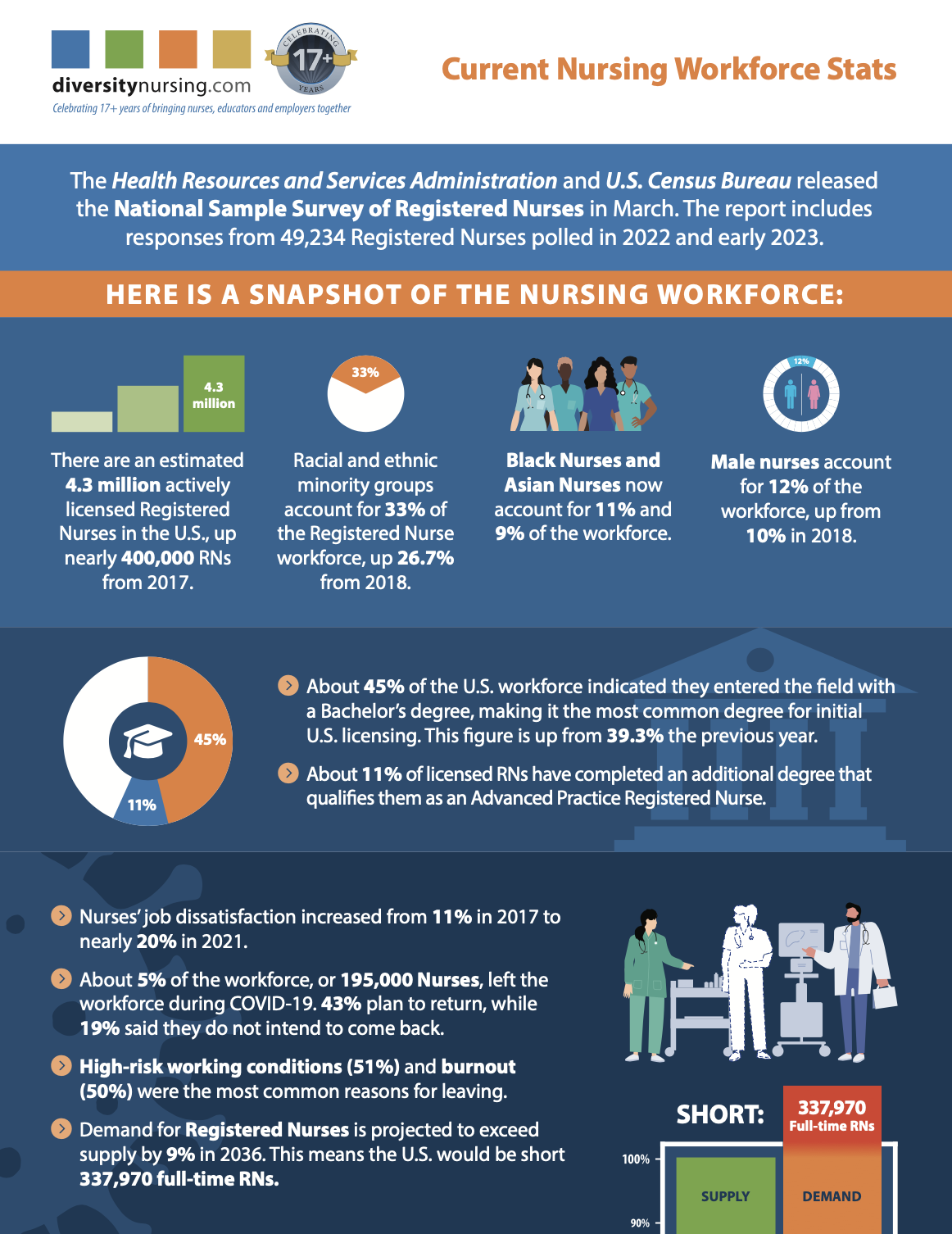
Source: https://bhw.hrsa.gov/data-research/access-data-tools/national-sample-survey-registered-nurses
The headline and subheader tells us what you're offering, and the form header closes the deal. Over here you can explain why your offer is so great it's worth filling out a form for.
Remember:
Posted by Diversity Nursing
Wed, May 01, 2024 @ 09:51 AM

Source: https://bhw.hrsa.gov/data-research/access-data-tools/national-sample-survey-registered-nurses
Topics: nurses, nursing workforce, healthcare workforce
Posted by Erica Bettencourt
Tue, Oct 24, 2023 @ 10:39 AM
Creating a healthy work environment for Nurses should be a top priority for employers in the healthcare industry. Nurses play a vital role in patient care, and their well-being directly impacts the quality of care they provide. By addressing some of the biggest issues in Nursing today, such as recruitment, retention, burnout, and bullying, employers can create a positive and supportive work environment that ultimately benefits both Nurses and patients.
Recruitment and retention are ongoing challenges in the industry. Many healthcare facilities struggle to attract and retain qualified Nurses, leading to staffing shortages and increased workload for the existing staff. By focusing on creating healthy work environments, employers can make their organizations more appealing to prospective Nurses and enhance employee satisfaction and loyalty. A positive work environment with adequate resources, support, and opportunities for professional growth can attract and retain talented Nurses, ensuring a stable workforce and improving patient outcomes.
Burnout is a pervasive issue among Nurses, resulting from the demanding nature of their work and high levels of stress. A negative work environment can exacerbate burnout and its associated physical, emotional, and mental exhaustion.
A McKinsey Health Institute (MHI) report found a direct correlation between a workplace's toxicity and the levels of stress and burnout reported by its employees. According to this research, employees are almost 8 times more likely to report symptoms of burnout when faced with high levels of toxic workplace behavior.
Employers need to prioritize the well-being of their Nursing staff by implementing strategies that promote work-life balance, provide access to support services, and encourage self-care. By fostering a culture of wellness and offering resources to manage stress, employers can mitigate burnout and create an environment where Nurses feel valued and supported.
Bullying is another significant issue that affects Nurses' well-being and job satisfaction. Workplace bullying can lead to increased stress, anxiety, and decreased morale among Nurses, ultimately impacting patient care.
According to an article from the National Library of Medicine, "A significant percentage of Nurses leave their first job due to the negative behaviors of their coworkers, and bullying is likely to exacerbate the growing Nurse shortage. A bullying culture contributes to a poor Nurse work environment, increased risk to patients, lower Hospital Consumer Assessment of Healthcare Providers and Systems (HCAHPS) patient satisfaction scores, and greater Nurse turnover."
Health systems must take proactive measures to prevent and address bullying in the workplace. This includes implementing clear policies against bullying, providing training on respectful communication and conflict resolution, and fostering a culture of respect and collaboration. By creating a safe and respectful work environment, employers can empower Nurses to excel in their roles and provide the best possible care to patients.
Negative workplaces not only harm the well-being of Nurses but also contribute to disengagement and decreased job satisfaction. When Nurses feel unsupported, unappreciated, or overwhelmed by their work environment, they are more likely to become disengaged, which can ultimately lead to decreased productivity and compromised patient care. Employers must recognize the impact of the work environment on Nurse engagement and take steps to create a positive and empowering atmosphere. This can be achieved through open communication, involving Nurses in decision-making processes, and providing opportunities for professional development and growth.
In conclusion, creating a healthy work environment for Nurses should be a top priority for employers. By addressing issues such as recruitment, retention, burnout, and bullying, employers can create a positive and supportive workplace that enhances Nurses' well-being and improves patient care. Investing in the well-being of Nurses not only benefits the individuals but also contributes to the overall success of healthcare organizations. Employers must recognize the crucial role Nurses play in healthcare and take proactive steps to ensure their work environment fosters their growth, satisfaction, and ultimately, the provision of high-quality patient care.
Topics: nursing, nurse, nursing career, nursing staff, nursing stress, nurse engagement, nursing workforce, workplace culture, healthy workplace, healthcare workforce, nursing field, inclusive workplace, work environment
Posted by Erica Bettencourt
Wed, Aug 24, 2022 @ 02:11 PM
 Hospitals are hiring or accepting volunteer teens and young adults as a long-term strategy to help combat shortages in the healthcare industry.
Hospitals are hiring or accepting volunteer teens and young adults as a long-term strategy to help combat shortages in the healthcare industry.
Research shows, exposure to various healthcare fields is crucial to the development of career interests for adolescents and young adults.
Earn while you learn programs give high school students the opportunity to gain knowledge in the field and make a better wage than the average part time jobs students often take.
These programs offer roles such as:
According to Becker's Hospital Review, Mount Carmel launched its inaugural patient-facing role for those 16 and older: a student support associate position.
Student support associates work as part of the care team, with a multi-skilled technician. The younger workers can help with tasks such as bathing patients, taking patients' vital signs and restocking equipment.
"We did elect to have specific criteria that students coming to us are actively enrolled in a Nursing program or a pre-Nursing program throughout their high school [career], so that we are really looking to support and foster their interest in long-term career growth and positioning them well to continue to work for us after they graduate from high school and ultimately matriculate into a Nursing program or another allied health program," Mount Carmel Regional Director of Talent Acquisition Rachel Barb told Becker's.
Volunteer programs help plant the seed and further educational opportunities for young adults.
Inova Fairfax Hospital in Virginia offers a volunteer Summer program where teens get to learn about different positions in the hospital and get hands-on experience at the hospital’s simulation lab.
Dr. Steve Narang, President of Inova Fairfax Medical Campus says to volunteers, "We are taking care of human beings, and this is just a gateway whether you want to be an accountant, whether you want to be in security, whether you want to be in IT or whether you want to be at the bedside. There’s a job for you in healthcare.”
Abrazo West Campus Hospital in Arizona hosts a volunteer program with interactive workshops.
“In those workshops, they have someone’s undivided attention, so they have a surgeon, a specialist, a radiologist that’s up there, and they tell them everything from A to Z, salary, challenges, rewards, education, the best career paths to take,” said Barry Worman, Director of Volunteer Services.
The Healthcare industry will continue to face workforce shortages in the near future so it’s crucial health systems offer opportunities like this to fill the gaps.Topics: nursing shortage, healthcare, healthcare industry, healthcare careers, healthcare organizations, healthcare hiring, healthcare workforce, healthcare staffing, teen volunteer programs, hospital volunteer, hospital volunteer program, hospitals hiring
 As we start the new year, we take a look at trends we expect to see in the Nursing field. Many health experts agree staffing has been and will continue to be the top healthcare issue.
As we start the new year, we take a look at trends we expect to see in the Nursing field. Many health experts agree staffing has been and will continue to be the top healthcare issue.
Many factors play into the staffing crisis like the pandemic, retiring Nurses, and high rates of burnout.
Rhonda Thompson, DNP, CNO and SVP of Patient Care Services at Phoenix Children's Hospital told Beckers Hospital Review, "The nursing shortage affecting health systems nationwide will continue to be a challenge in 2022. This has a greater impact than just unfilled positions and scheduling sufficient nurses based on a high patient census. It also means our experienced staff nurses are investing a great deal of time onboarding and training newly licensed nurses, in addition to their own daily bedside care responsibilities. To solve this, it will take collaboration and commitment from our health systems, staff, and academic partners."
According to the U.S. Bureau of Labor Statistics, about 194,500 openings for Registered Nurses are projected each year, on average, over the decade. Many of those openings are expected to result from the need to replace workers who transfer to different occupations or exit the labor force, such as to retire.
The COVID-19 pandemic created a demand for at-home healthcare that continues to grow.
According to Forbes, the Home Care Providers industry is among the fastest growing healthcare industries in the United States. "Industry revenue, according to IBISWorld, has grown at an annualized rate of 2.2% to $96.9 billion over the past five years."
At-home healthcare has many benefits. So much so, last year a bill called the Choose Home Care Act 2021 was presented to Congress. If passed, this would give patients the opportunity to leave the hospital and recover at home with a mix of expanded skilled Nursing, therapy, personal care, telehealth services, and more.
The pandemic has pushed an already stressed-out career field to its breaking point. Nurses are facing high rates of burnout and compassion fatigue.
Compassion fatigue is the emotional residue or strain of exposure to working with those suffering from the consequences of traumatic events.
According to J. Maben and J. Bridges (2020), the pandemic has led Nurses to experience the highest level of stress that has ever been recorded compared to other professions.
Healthcare organizations and leaders have the opportunity and the responsibility to support and prioritize their staff's mental and physical well-being.
These healthcare workers have given so much of themselves they have nothing left to give and yet they are still showing up day after day under impossible circumstances. But for how much longer?
Nurses want to feel valued and safe in their work environment. Healthcare organizations must ensure Nurses are equipped with resources and the support they need to provide quality care.
The pandemic forced Nursing schools to provide their classes online to avoid the spread of the virus. Many institutions have continued the online learning option for some of their programs.
According to a report from Inside Higher Ed, about 60% of colleges and universities do plan to keep some of their undergraduate programs fully online.
Online schools provide a great opportunity for Nurses who are looking to advance further in their education, but don't have the time to physically attend classes between shifts.
Topics: well being, nursing shortage, nursing trends, healthcare workers, healthcare workforce, healthcare trends, healthcare issues, 2022 healthcare trends, online nursing school
Agreement to publish on our DiversityNursing.com Blog is at our sole discretion.
Thank you
©2025 DiversityNursing.com